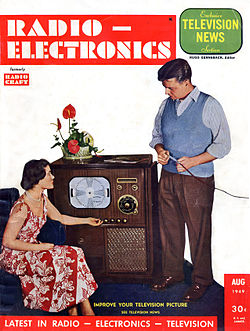Radio electronics

The August 1949 issue of Radio-Electronics with Radio-Craft tag line.
|
|
| Publisher | Electro Importing Company |
|---|---|
| First issue | July 1929 (as Radio-Craft) |
| Final issue | January 2003 |
| Website | radio-electronics |
Radio-Electronics was an American electronics magazine that was published under various titles from 1929 to 2003. Hugo Gernsback, sometimes called by Americans as The Father of Science Fiction, started it as Radio-Craft in July 1929. The title was changed to Radio-Electronics in October 1948 and again to Electronics Now in July 1992. In January 2000 it was merged with Gernsback's Popular Electronics to become Poptronics. Gernsback Publications ceased operations in December 2002 and the January 2003 issue was the last. Over the years, Radio-Electronics featured audio, radio, television and computer technology. The most notable articles were the TV Typewriter (September 1973) and the Mark-8 computer (July 1974). These two issues are considered milestones in the home computer revolution.
In 1905 Hugo Gernsback established Electro Importing Company to sell radio components and electrical supplies by mail order. The catalogs had detailed instructions on projects like a wireless telegraph outfit and were the predecessor of his first magazine, Modern Electrics (April 1908). Gernsback sold Modern Electrics in March 1913 and it became Electrician and Mechanic. In May 1913 he started another magazine, The Electrical Experimenter. Gernsback was an enthusiastic supporter of amateur radio. Gernsback started a magazine devoted to radio, Radio Amateur News (July 1919.) The title was shortened to Radio News in July 1920.
Radio News was a very successful magazine that enabled Hugo Gernsback and his brother Sidney to build a publishing empire. Amazing Stories was introduced in April 1926 and was the first magazine devoted to science fiction. In 1925 they launched the radio station WRNY. This was the first radio station to broadcast experimental television starting in 1928.
In February 1929 Gernsback's Experimenter Publishing was forced into bankruptcy. Everything was sold to pay off the creditors. At the last court proceeding in April 1929, Hugo Gernsback announced a new publishing company. "Mr. Gernsback said after the hearing that his new magazines would be Radio Craft, Science Wonder Stories and Air Wonder Stories and that the first issues would be out in June."
...
Wikipedia
